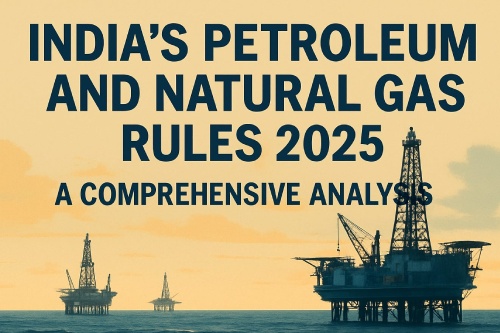India’s energy landscape is characterized by stark dependencies that underscore the urgency of regulatory reform. India has an 82.8% import dependence for crude oil and 45.3% for natural gas, creating significant vulnerability to global supply disruptions and price volatility. Against this backdrop, India’s crude oil production stood at 19.88 MMT during April-January 2025, representing a marginal contribution to the country’s massive energy requirements.
The regulatory framework governing this critical sector had remained largely unchanged since independence, with the rules seeking to replace the outdated Petroleum Concession Rules, 1949 and Petroleum and Natural Gas Rules, 1959. This 76-year regulatory lag had created substantial inefficiencies in India’s upstream sector, necessitating comprehensive reform.
Regulatory Architecture and Modernization
The Draft Petroleum and Natural Gas Rules 2025 represent a fundamental shift from concession-based regulation to a more investment-oriented framework. The revised Model Revenue Sharing Contract (MRSC) reflects the new operational and fiscal realities of the sector, indicating a move toward more flexible commercial arrangements. Key analytical observations include:
Structural Transformation: The rules consolidate multiple regulatory instruments into a unified framework, reducing compliance complexity and administrative overhead. This consolidation addresses a critical inefficiency where operators previously navigated multiple, often conflicting regulatory requirements.
Investment Incentivization: The new framework incorporates specific provisions designed to attract both domestic and foreign investment, recognizing that India’s upstream sector requires substantial capital infusion to achieve production targets.
Technology Integration: Modern technological standards are embedded within the regulatory framework, enabling operators to deploy advanced exploration and production technologies without regulatory impediments.
Comparative Analysis:1949-1959 vs 2025 Framework
The transformation from the legacy framework to the 2025 rules reveals significant philosophical and practical shifts:
Scope Expansion: While the 1949 and 1959 rules focused primarily on concession allocation and basic operational requirements, the 2025 framework encompasses comprehensive lifecycle management, including environmental considerations, technology standards and international best practices.
Commercial Flexibility: The legacy framework operated on rigid concession models with limited flexibility for changing market conditions. The 2025 rules introduce dynamic commercial arrangements that can adapt to evolving market realities.
Regulatory Efficiency: The new framework emphasizes regulatory efficiency through streamlined approval processes, reduced bureaucratic layers and clearer timelines for regulatory decisions.
The 2nd edition of Urja Varta 2025, India’s premier upstream oil and gas conclave, was held today at Bharat Mandapam, New Delhi. The most significant announcement at Urja Varta 2025 concerned India’s future investment trajectory. Minister Puri highlighted that India has invested over ₹4 lakh crore in energy infrastructure over the past decade and projected an investment of ₹30–35 lakh crore over the next ten years. This represents a 750-875% increase in investment intensity, indicating the government’s commitment to transforming India’s energy landscape.
Sectoral Growth Projections
Refining Capacity Expansion: Indian refining capacity has increased from 215.1 MMTPA to 256.8 MMTPA in last 10 years and is projected to increase to 309.5 MMTPA by the year 2028. This 20.5% projected increase in refining capacity by 2028 indicates significant downstream expansion that will require corresponding upstream development.
Natural Gas Consumption Growth: Natural gas consumption is predicted to increase at a CAGR of 12.2%, from 174 MCMPD in 2021 to 550 MCMPD by 2030. This 216% increase in natural gas consumption over the decade creates substantial opportunities for domestic production enhancement.
Engineering and Construction Services
The projected investment of ₹30-35 lakh crore will have multiplicative effects on India’s engineering and construction sector. Historical analysis suggests that every rupee invested in upstream oil and gas typically generates 2.5-3 rupees in engineering and construction activity, implying a potential ₹75-105 lakh crore opportunity for the construction sector.
Technology and Digital Services
The emphasis on technology integration within the new regulatory framework is expected to drive substantial demand for digital oilfield services, advanced seismic technologies and data analytics capabilities. This could potentially create a domestic market worth ₹2-3 lakh crore over the next decade.
Financial Services Impact
The massive investment projections will require sophisticated financial instruments and risk management products. The banking and financial services sector is expected to develop specialized products for upstream oil and gas financing, potentially creating a new sub-sector within energy finance.
Strategic Challenges and Opportunities
With India’s current 82.8% crude oil import dependency, even modest improvements in domestic production could have significant economic impact. A 10% improvement in domestic production could reduce import bills by approximately $15-20 billion annually, based on current consumption patterns and crude oil prices.
Technology Transfer and Skill Development
The new regulatory framework’s emphasis on technology adoption creates opportunities for technology transfer and domestic skill development. The projected investment levels suggest potential employment generation of 2-3 million jobs across the value chain over the next decade.
Environmental and Transition Considerations
The rules must balance conventional hydrocarbon development with India’s net-zero commitments by 2070. The framework’s flexibility allows for integration of carbon capture and storage technologies, potentially positioning India as a leader in sustainable hydrocarbon development.
Strategic Implications for India’s Energy Future
The PNG Rules 2025 represent a inflection point in India’s energy policy, addressing decades of regulatory inertia while positioning the country for substantial upstream sector growth. The projected ₹30-35 lakh crore investment over the next decade, if realized could fundamentally transform India’s energy security profile and reduce import dependencies.
The success of this regulatory transformation will depend on effective implementation, continued policy support and the ability to attract and deploy capital efficiently. The scale of projected investment suggests that India is positioning itself not just as a major energy consumer but as a significant player in global energy production and technology deployment.
For industry stakeholders, the new framework offers unprecedented opportunities for growth and innovation while for policymakers, it provides a robust platform for achieving energy security objectives. The true test of these reforms will be their ability to translate regulatory modernization into tangible improvements in India’s energy security and economic competitiveness.
Author is part of the team organizing Lubricant India Expo & Summit 2026, South Asia’s only specialized exhibition on Lubricants, Additives and base oils. Analysis based on official government announcements, industry data and regulatory documents as of July 2025. Investment projections and market impact of these rules will continue to evolve as the sector adapts to the new regulatory environment.
Explore more about expo at www.lubricantindia.com


